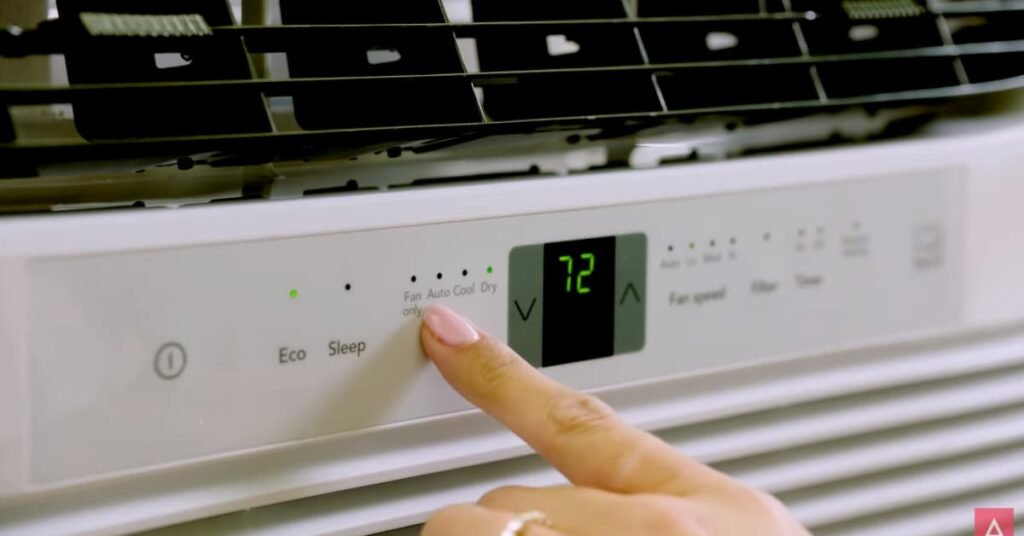What Does Dry Mode Mean On A Window Air Conditioner?
Window air conditioners come with various modes to cater to different cooling needs. One of these modes is the “Dry Mode,” which serves a specific purpose in maintaining indoor comfort levels.
Understanding how Dry Mode works and when to use it can enhance the efficiency of your air conditioner while improving the overall air quality in your space.
Dry Mode Mean On A Window Air Conditioner
Dry mode on a window air conditioner helps reduce humidity without intense cooling. It operates the compressor and fan at a slower speed, extracting moisture without changing the room’s temperature much. This setting prioritizes dehumidification, making it energy-efficient.
Using dry mode offers benefits like creating a comfortable indoor environment, especially in hot and humid weather. Lower humidity levels can prevent mold, odors, and damage to belongings. It can also save energy compared to full cooling. Dry mode is best used when dehumidification is necessary without a significant temperature drop. It works well in mild weather when cooling isn’t needed but humidity is high.
This mode is suitable for maintaining comfort and air quality without overcooling. It’s also effective in rooms prone to feeling damp or stuffy.
Functionality
Dry mode on a window air conditioner reduces humidity without intense cooling by operating the compressor and fan at a slower speed. This setting helps extract moisture from the air without significantly changing the room’s temperature.
Instead of focusing solely on cooling, dry mode prioritizes dehumidification, making it an energy-efficient option. When activated, the air conditioner’s compressor compresses refrigerant gas at a slower rate, leading to less cooling but effective dehumidification. The fan then circulates the drier air back into the room while expelling excess moisture outside.
This process helps create a more comfortable indoor environment by reducing humidity levels without overcooling. Window air conditioners with dry mode are suitable for situations where dehumidification is needed without a drastic temperature drop.
Benefits
1. Comfortable Environment: Dry mode helps maintain a comfortable indoor atmosphere by reducing humidity levels without causing drastic temperature fluctuations. This ensures a cozy living space without the need for intense cooling.
2. Mold Prevention: By lowering humidity levels, dry mode effectively inhibits the growth of mold and mildew in the room. This feature is essential for maintaining a healthy environment and preventing potential respiratory issues associated with mold exposure.
3. Belongings Protection: Utilizing dry mode on a window air conditioner safeguards belongings from moisture-related damage that can occur in high-humidity conditions. This protection extends the lifespan of furniture, electronics, and other items susceptible to humidity-induced deterioration.
4. Energy Efficiency: Dry mode consumes less energy compared to full cooling mode, making it a cost-effective option for managing indoor humidity levels. By using this setting, users can reduce their electricity consumption and lower utility bills while still enjoying a comfortable living environment.
5. Ideal for Hot Weather: During hot and humid weather conditions, dry mode is particularly beneficial for combating excess moisture in the air. It helps create a more pleasant indoor environment by reducing humidity without overcooling the room, providing relief from the discomfort associated with high humidity levels.

When to Use Dry Mode?
Using the dry mode on a window air conditioner can be a great way to manage indoor humidity levels. This setting can create a more comfortable living environment without the need for constant cooling.
During Humid Weather
Humid weather can make your home feel uncomfortable, even if the temperature isn’t very high. Dry mode is perfect for these situations. It reduces the moisture in the air, making your home feel cooler and more pleasant. Instead of constantly running the air conditioner in cooling mode, switching to dry mode can effectively manage humidity without overcooling your space. This helps in maintaining a comfortable atmosphere while conserving energy.
When the Temperature is Moderate
On days when the temperature is not too hot but the humidity is high, using the dry mode is ideal. This setting dehumidifies the air without significantly lowering the temperature. It is especially useful during the spring and fall seasons when the weather is mild. By using dry mode during these times, you can ensure your home remains comfortable without the need for extensive cooling, leading to lower energy consumption and costs.
To Prevent Mold and Mildew
High humidity levels in your home can lead to the growth of mold and mildew. These can cause health issues and damage your property. Using the dry mode on your window air conditioner helps control indoor humidity levels, thereby preventing mold and mildew growth. By keeping the humidity in check, you can protect your home and maintain a healthier living environment. Regular use of dry mode can be an effective preventive measure against these problems.
At Night for Better Sleep
Sleeping in a humid environment can be uncomfortable and disrupt your sleep. Using dry mode at night can create a more comfortable sleeping environment by reducing humidity. This can lead to better sleep quality without making the room too cold. The dry mode operates quietly, making it an excellent choice for nighttime use. By improving the air quality and comfort level, you can enjoy a restful night’s sleep.
To Save Energy and Costs
Running the air conditioner in cooling mode all the time can increase your energy bills. Dry mode consumes less energy than cooling mode because it focuses on dehumidifying the air rather than cooling it. This can lead to significant energy savings over time. By using dry mode when appropriate, you can lower your energy consumption and reduce your utility bills. It’s an efficient way to maintain comfort without compromising on cost.
During Rainy Seasons
Rainy seasons often come with high humidity levels, making your home feel damp and uncomfortable. Using the dry mode on your window air conditioner during this time can effectively manage indoor humidity. It helps to remove excess moisture from the air, making your home feel drier and more comfortable. This setting is particularly useful during prolonged rainy periods when the humidity remains high for days.

7 Tips for Using Dry Mode Efficiently
Using dry mode efficiently on a window air conditioner can greatly enhance your indoor comfort while saving energy. This mode is designed to reduce humidity, making your home feel cooler without excessive cooling.
Here are some practical tips to help you use dry mode effectively.
1. Monitor Humidity Levels
To use dry mode efficiently, keep an eye on the humidity levels in your home. You can use a hygrometer to measure humidity. Ideal indoor humidity levels range from 30% to 50%.
When humidity rises above this range, it’s time to switch on dry mode. By regularly monitoring humidity, you can ensure your air conditioner operates efficiently, maintaining a comfortable environment without unnecessary energy use.
2. Use Dry Mode During Humid Hours
Dry mode is most effective during the most humid parts of the day. Typically, humidity peaks in the early morning and late evening. By using dry mode during these times, you can efficiently manage indoor moisture levels.
This targeted use helps maintain comfort and prevents overuse of your air conditioner, leading to energy savings. It’s a simple yet effective strategy to enhance indoor air quality.
3. Keep Windows and Doors Closed
For dry mode to work efficiently, keep all windows and doors closed. This prevents outside humidity from entering and ensures the air conditioner can effectively reduce indoor moisture.
Sealing any gaps and using weatherstripping can also help. By maintaining a closed environment, you enhance the efficiency of dry mode, leading to better humidity control and energy savings.
4. Combine with a Dehumidifier
In extremely humid conditions, combining your air conditioner’s dry mode with a separate dehumidifier can be very effective. This combination can quickly bring down humidity levels. Use the dehumidifier in the most humid rooms, like basements or bathrooms. This strategy can make your air conditioner’s job easier, improving overall efficiency and indoor comfort.
5. Set the Right Temperature
When using dry mode, set the temperature to a comfortable level, typically around 24-26 degrees Celsius (75-78 degrees Fahrenheit). This setting allows the unit to dehumidify the air without overcooling the space.
By setting an appropriate temperature, you ensure the air conditioner operates efficiently, providing comfort without excessive energy use.
6. Use Fans to Circulate Air
Using fans in conjunction with dry mode can help circulate the dehumidified air throughout your home. This promotes even distribution of air, enhancing the effectiveness of the dry mode.
Ceiling fans or portable fans can be used to move air and prevent any single area from becoming too humid. This simple step can improve comfort and air quality.
7. Schedule Usage
Consider scheduling the use of dry mode during periods when you know humidity will be high. Many modern air conditioners come with programmable timers. Use these timers to set dry mode during peak humidity hours.
This planned usage ensures the unit operates when needed most, maximizing efficiency and comfort without manual intervention.
Conclusion
This mode is ideal for maintaining a comfortable environment without excessively cooling the space. It is particularly useful during humid weather, helping to prevent mold and mildew growth. Using dry mode can also save energy, as it consumes less power than the regular cooling mode. It’s an efficient way to improve indoor air quality and comfort.






